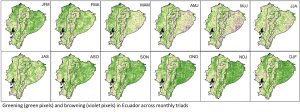Forest Cover Change and Biodiversity Conservation in Coastal Ecuador

Coastal Ecuador is considered an area of high priority for global conservation efforts because of its high number of endemic species but the very low remaining native vegetation coverage. Starting with my M.Sc. research, I have been investigating changes in forest cover and the implications of these changes for biodiversity in Manabí province, central coastal Ecuador. Key findings to present include:
– About 50% of forests present in 1990 in a landscape considered one of the last remnants of semi-deciduous tropical forest have been clear to 2015. What remains are mostly forests with various degrees of degradation.
– The shape of forest patches seems to be critical at explaining diversity values across fragments
of different forest types.
– Preserving remaining old-growths forests will preserve also the highest amount of aboveground
biomass. Having secondary growth or plantation forest could result in similar aboveground
biomass numbers, but contrasting diversity values.
– Big landowners own most old-growth forest patches. Smallholders own no forests, but are more
willing to engage in conservation practices.
– Farmer´s perceptions of different management goals indicate some synergies between
conservation and land-use preferences.
Current Collaborators
– Jon Johnston (former undergraduate student at Humboldt State University; currently at
California Department of Fish and Wildlife)
– Juliana Bedoya (Department of Wildlife Ecology and Conservation, University of Florida).
Past Collaborators
– Hannah Ruth Lyons-Galante (former undergraduate student at Harvard University)
– Trent Blare (former PhD student at the University of Florida)
Publications associated with this project
Haro-Carrión, X., & J. Southworth. 2018. Understanding land-cover change in a fragmented forest landscape in a biodiversity hotspot of Coastal Ecuador.
Remote Sensing 10(12): 1980; https://doi.org/10.3390/rs10121980
Lyons-Galante, H.R., & X. Haro-Carrión. 2017. Effect of distance from edge on exotic grass abundance intropical dry forests bordering pastures in Ecuador.
Journal of Tropical Ecology 33: 170-173.
Changes in Vegetation Greenness in Continental Ecuador

Tropical ecosystems are greening in response to changes in climate, yet less is known about greening patterns in the tropical Andes compared to other tropical regions. In this project, started during my PhD, I use GIMMS NDVI data to evaluate changes in vegetation greenness across the coastal, Andean, and Amazonian regions of Ecuador, from 1982-2010. Findings to date indicate overall significant greening, or NDVI increase, after the mid ’90s, with distinct seasonal variations across regions and with a different relationship to precipitation regimes.
Current Collaborators
– Peter Waylen (University of Florida)
– Jane Southworth (University of Florida)
In Progress Journal Articles
Haro-Carrión, X., P. Waylen., & J. Southworth. Spatiotemporal changes in vegetation greenness across continental Ecuador: a Pacific-Andean-Amazonian gradient, 1982-2010.
In preparation for Journal of Land Use Science